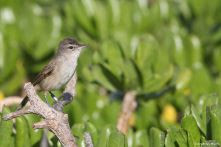Hawaiʻiʻs Millerbird no longer listed as critically endangered after successful relocation : Maui Now

[ad_1]

With decades of conservation work paying off, Hawai‘i’s Millerbird that is also known as Ulūlu has been downlisted to Endangered status after being listed as Critically Endangered since 2000.
The announcement was made on Monday by the International Union for Conservation of Nature’s Red List of Threatened Species.
The Ulūlu was once found only on the island of Nihoa, an uninhabited Northwestern Hawaiian Island. But a team of scientists and conservationists with the US Fish and Wildlife Service and the American Bird Conservancy in 2011 and 2012 translocated 50 individuals to Laysan, another uninhabited Northwestern Hawaiian island about 808 mies northwest of Honolulu, creating a second, self-sustaining population that significantly decreased this species’ risk of extinction.
“The Millerbird translocations were an exciting, collaborative victory for Hawaiian conservation and it is immensely rewarding seeing this recognized by [the International Union for Conservation],” said Chris Farmer, the Hawai‘i program director for the American Bird Conservancy who participated in the translocations.
“The population increase on Laysan will help protect this species’ future, and shows that long-term support and commitment can prevent extinctions of any other Hawaiian birds.”
The Millerbird, a small insect-eating warbler, was once found on both Nihoa and Laysan (Kauō) Islands in the Northwestern Hawaiian Islands. Tragically the population on Laysan went extinct by the early 20th century, along with two other endemic bird species, the Laysan Rail and Laysan Honeycreeper, due to loss of vegetation from nonnative rabbits and other introduced mammals. After that, the species was limited to a few hundred individuals on the rocky, 178-acre Nihoa, 650 miles away from Laysan.
To prevent another extinction from happening, a goal was set to establish a second “insurance” population of Millerbirds on Laysan. Rabbits and other invasive mammals were removed from Laysan by 1923. After years of natural regeneration and intensive habitat restoration by the US Fish and Wildlife Service, the island had recovered sufficiently to make it suitable for the Millerbird reintroduction effort.
The Millerbirds were translocated to Laysan, which at 1,023 acres is the second largest of the Northwestern Hawaiian Islands and is located in the Papahānaumokuākea Marine National Monument that is one of the largest environmentally protected marine areas in the world.
Experts estimate that several hundred Millerbirds inhabit Laysan today, and they have expanded into all the vegetated parts of the island.
The first translocation of 24 Millerbirds took place in September 2011 after years of research and preparation, followed by a second translocation of 26 birds in 2012. Working with the monument’s Native Hawaiian Cultural Working Group, the translocated population received the name Ulūlu niau.
To understand the fate of the translocated birds, their movements and breeding activity, birds were marked with a unique set of color bands on their legs, making it easier to track individuals. Research entailed tracking a subset of the birds with temporary radio transmitters, nest monitoring and re-sighting color-banded birds as frequently as possible. This was not an easy task due to Millerbirds’ secretive nature in the dense, bushy habitat they frequent on Laysan.
The year 2023 is the centennial of the extinction of the Laysan subspecies of Millerbird.
“It’s remarkable to think that exactly 100 years later, the Millerbird is now being downlisted, because Millerbirds are once again flourishing on Laysan,” said George Wallace, former Vice President for Oceans and Islands and now a volunteer Ambassador at the American Bird Conservancy. “It’s rewarding seeing these birds thrive, not only because they have been a missing piece of the island’s native ecosystem for so long, but also because this marks a turning point in the recovery of the species.”
Wallace was a member of the Millerbird translocation team.
The Millerbird isn’t the only endangered species benefiting from the conservation efforts on Laysan. The Laysan Finch (‘Ekupu‘u), Laysan Duck and several plant species, along with millions of nesting seabirds such as Laysan Albatross (Mōlī) and Black-footed Albatross (Ka‘upu) continue to do well.
While the work to restore Laysan and recover the Millerbird are beacons of success, it is sobering to note that once a bird paradise, Hawai‘i is now the bird extinction capital of the world with many species on the brink and more at risk of disappearing in our lifetime.
Since human settlement of the islands, 95 of 142 bird species found nowhere else have become extinct in Hawai‘i, and 26 of Hawai‘i’s remaining 37 endemic birds are listed under the Endangered Species Act. Three of these have not been seen in decades, and an additional eight were recently declared extinct.
The remaining birds face multiple threats, ranging from loss of their unique feeding and nesting areas to direct predation by invasive species, and avian malaria and pox transmitted by non-native mosquitoes, diseases which have decimated populations of Hawaiian birds.
The Millerbird Project was also made possible by the National Fish and Wildlife Foundation, Pacific Bird Conservation, Papahānaumokuākea Marine National Monument, Pacific Rim Conservation, University of Hawai‘i, University of New Brunswick, U.S. Geological Survey National Wildlife Health Research Center and Office of Hawaiian Affairs.
For more information, visit ABC’s Millerbird Project and ABC’s Hawai‘i Program.
[ad_2]
Source: Maui News




